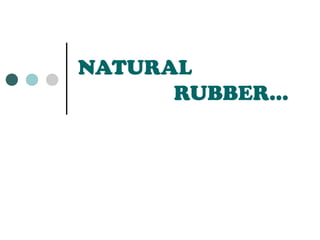
Chapter 12 rubbers
- 1. NATURAL RUBBER…
- 2. NATURAL POLYMERS POLYMER MONOMER 1. PROTEIN AMINO ACID 2. CARBOHYDRATE GLUCOSE 3. NATURAL RUBBER ISOPRENE 4. STARCH GLUCOSE 5. CELLULOSE GLUCOSE
- 5. PROPERTIES OF NATURAL RUBBER
- 8. TO PREVENT COAGULATION OF LATEX Hydroxide ions, OH- from alkali neutralise H+ produced by acid as a result of bacterial attack on protein The protein membrane remains negatively charged because there is no hydrogen ion, H+ The rubber particles repel each other The rubber polymers cannot combine and coagulate
- 9. VULCANIZATION OF RUBBER DEFINITION: Process for hardening rubber by treating it with sulphur compound. PURPOSE : To improves the qualities/weakness of natural rubber (unvulcanized rubber)
- 10. COMPARING AND CONSTRAST THE PROPERTIES OF VULCANIZED & UNVULCANIZED RUBBER
- 11. MECHANISM OF VULCANIZATION OF LATEX ]]] The presence of cross-linkage of sulphur atoms between the rubber molecules ]]] When vulcanized rubber is stretched and release, the cross-linkage will ; pull the chains back to their original arrangement. So, it improves the elasticity & strength of the rubber - increase the size of rubber molecules -make vulcanized rubber more resistant to heat & organic solvents C=C Vulcanised rubber < C=C Unvulcanised rubber,
- 12. COMPARING AND CONTRASTING THE PROPERTIES OF VULCANIZED AND VULCANIZED RUBBER Similarities : Elasticity & Heat and electrical insulator Differences Vulcanized Rubber Unvulcanized Rubber More elastic Less elastic Harder Softer Stronger Weaker Can withstand higher Cannot withstand higher Temperature Temperature Less easily oxidized Easily oxidized Does not become soft & Becomes soft & sticky sticky easily easily
- 13. USES OF NATURAL RUBBER 1) Elasticity of rubber - making tyres, footwear,rubber threads, rubber foam, conveyor belts,rubberized bitumen roads 2) Many buildings that are near to railways @ situated in earthquake prone areas are build on rubber blocks @ rubber bearings which can help absorb vibration 3) Impermeability to gas @ liquid - Uses in gloves, tubes & hoses 4) Vulcanized Rubber + Carbon tyres /air craft tyres (to maintain their elasticity
